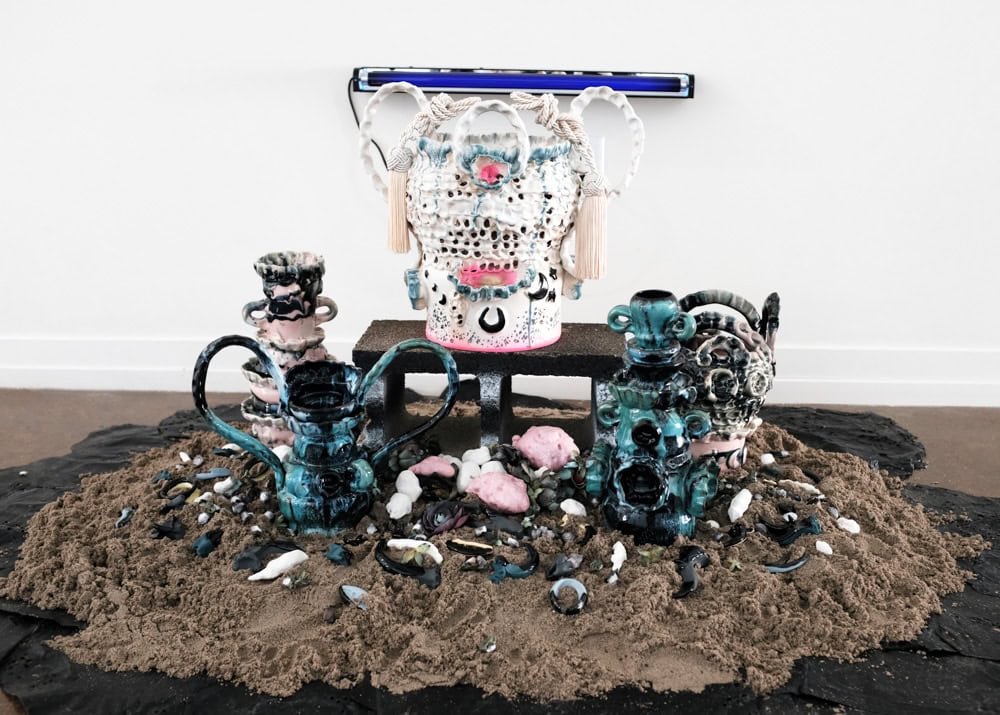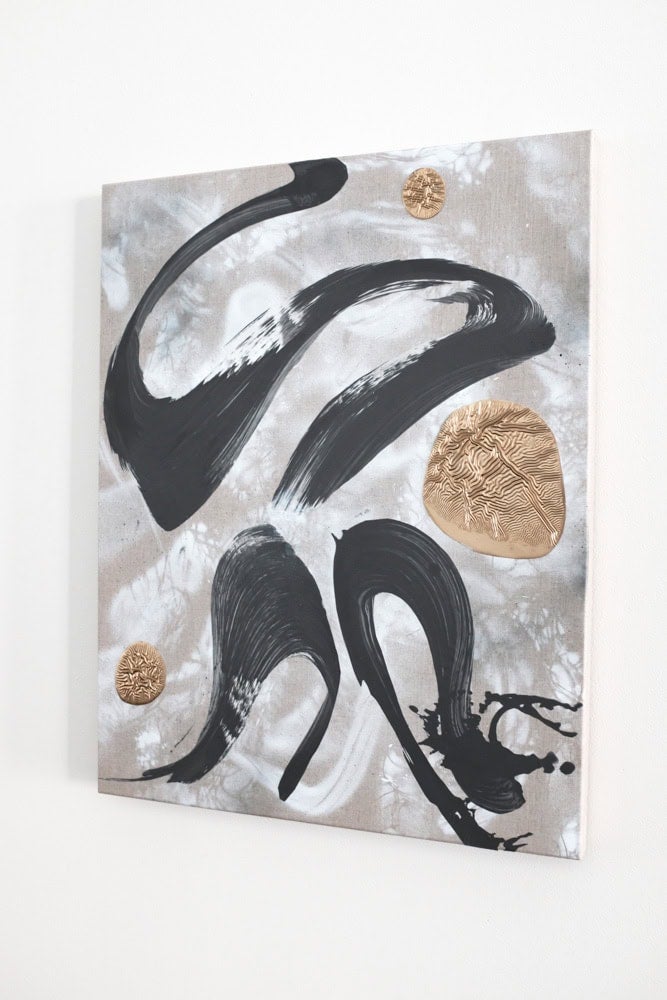
The last in a series of exhibitions Tennessee nonprofit Locate Arts has brought to venues around the state, Texturextra at Nashville’s Zeitgeist gallery pairs paintings by Nashville-based artist Richard Feaster with installation-based works by Atlanta-based artist Zipporah Thompson. Each show in the series has paired a Tennessee artist with an out-of-state collaborator, and the state-wide programming reads like a rehearsal for the first Tennessee Triennial, which Locate Arts will debut in 2021. In Texturextra, Thompson and Feaster pursue alchemical transformation by recontextualizing mundane objects and materials in startling works of art.
Thompson’s simultaneously irreverent and formal installations sometimes read as figurative characters. Crystal Vortex appears as a furry-faced totem creature in a kimono of pink and blue flowers. Its ostensible feet are made from an oblong hula-hoop—it’s as if magic mushrooms have a mascot. The figure recalls art’s psycho-shamanic origins, using banal objects like a plug-in pink salt lamp to evoke those oldest flickering caves where art first emerged. Thompson’s combination of found materials and hand-crafted elements gives these ramshackle altar spaces their power to charm. Her displays can appear slapdash at first glance but reward closer inspection. Blue Haze Equinox features a collection of jade and pink stoneware jugs with their bases pushed down into a pile of sand on top of a rug of rubber mulch. The addition of a blacklight in an already brightly lit gallery transforms the purple glowing rectangle from a utilitarian head shop lamp into a supercharged object in this ritualistic display.

Although they compared notes, Thompson and Feaster didn’t directly collaborate on the artworks in the exhibition, and one of the great strengths of Texturextra is the way each artist’s work echoes and supports the other’s harmoniously. Like Thompson’s installations, Feaster’s paintings operate through an investigation of materials. Feaster’s material-focused approach to painting has matured into a process exploring time and space. He pours thick blobs of paint which he dries into skins which can be glued onto painted canvases. These lugubrious blobs and runny drips look precarious, but they are strictly frozen in time. Sometimes they read like a send-up of the painterly excesses of expressionism, and Feaster’s technique is so tight that most viewers are surprised to find out that the elements have been glued into place and not directly applied with a brush. Feaster puts a twist on the trick when he paints what look like spontaneous calligraphic gestures on Mylar plastic before he literally cuts and pastes them onto his painted surfaces. In this show, he nods to the King of Rock and Roll by pulling off the same trick with abstract swatches of very thin black velvet. The textures of Feaster’s collaged surfaces speak to Thompson’s sculptural spaces—the overall display of the show often feels seamless. But the best aspect of Feaster’s contributions is way his contrived and considered cutting and pasting constitutes a sly subverting of Ab-Ex myths about macho mark-making. With these playful devices, Feaster connects his explorations of transformation back to American trickster fables in which humor, irreverence, and taboo-tweaking can reveal deep cultural lessons.
Feaster’s abstract drip studies make use of metallic gold paint, pointing to the purified proofs of those medieval alchemists who sought to transform base materials such as lead into gold and other precious substances. Feaster uses some type of metallic paint with just the right color and luster to pull off the illusion without looking either insubstantial or tacky. In fact, the gold paintings are my favorites in the show. Thompson’s works connect back to alchemy in her reclaiming of everyday found objects to be re-contextualized as aesthetic elements in her sacred and striking displays. In his book Psychology and Alchemy, Carl Jung wrote “For the alchemist the one primarily in need of redemption is not man, but the deity who is lost and sleeping in matter.” Texturextra is wide awake.
Presented by Locate Arts and featuring artists Zipporah Camille Thompson and Richard Feaster, Texturextra is on view at Zeitgeist in Nashville through June 29.




